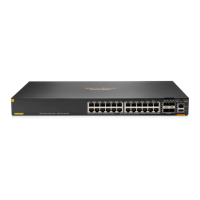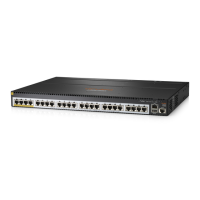129
When the temperature drops below the low-temperature threshold or reaches the high-temperature
warning threshold, the device does the following:
• Logs the event.
• Sends a log message.
• Sends a trap.
When the temperature reaches the high-temperature alarming threshold, the device does the
following:
• Logs the event.
• Sends log messages repeatedly.
• Sets the LEDs on the device panel.
To configure the temperature alarm thresholds:
Step Command Remarks
1. Enter system view.
system-view
N/A
2. Configure the temperature
alarm thresholds.
temperature-limit
slot
slot-number
hotspot
sensor-number lowlimit
warninglimit [ alarmlimit ]
To view the default settings, use
the
undo
temperature-limit
command to restore the defaults
and then execute the
display
environment
command.
The high-temperature alarming
threshold must be higher than the
high-temperature warning
threshold. The high-temperature
warning threshold must be higher
than the low temperature
threshold.
Verifying and diagnosing transceiver modules
Verifying transceiver modules
You can use one of the following methods to verify the genuineness of a transceiver module:
• Display the key parameters of a transceiver module, including its transceiver type, connector
type, central wavelength of the transmit laser, transfer distance, and vendor name.
• Display its electronic label. The electronic label is a profile of the transceiver module and
contains the permanent configuration, including the serial number, manufacturing date, and
vendor name. The data is written to the storage component during debugging or testing.
To verify transceiver modules, execute the following commands in any view:
Task Command Remarks
Display the key parameters of
transceiver modules.
display transceiver
{
interface
[ interface-type
interface-number ] }
N/A
Display the electrical label
information of transceiver
modules.
display transceiver manuinfo
interface
[ interface-type
interface-number ] }
This command cannot display
information for some transceiver
modules.

